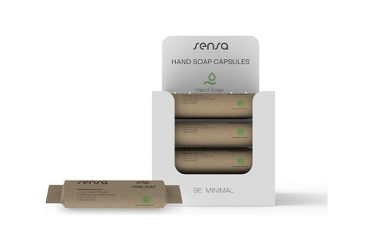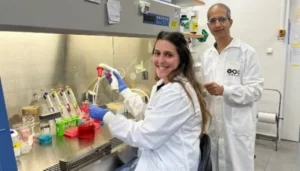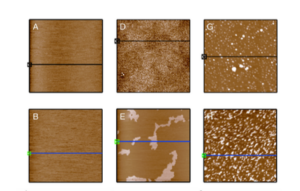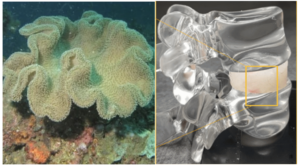Israël : l'Université de Tel Aviv et le Technion débarrassent l'eau potable de l'arsenic

[:fr]Les Drs Ray Keren et Boaz Mayzel à l’Université de Tel-Aviv ont découvert une bactérie qui emmagasine des quantités énormes d’arsenic, principal polluant des eaux souterraines. L’étude, réalisée en collaboration avec le Pr Boaz Pokroy du Technion et le Dr Sirine Fakra du laboratoire national Lawrence à Berkeley aux Etats-Unis, pourrait ouvrir la voie au développement d’un moyen rentable et efficace de purifier l’eau potable de cette toxine, et sauver la santé et la vie de dizaines de millions de personnes dans le monde. Elle suscite déjà un grand intérêt dans la communauté scientifique internationale.
« Les éponges sont les animaux les plus anciens existant aujourd’hui sur la planète« , explique le Prof. Ilan. « Elles servent d’habitat à de nombreuses créatures, filtrent sans cesse l’eau dans laquelle elles vivent, et en recueille de nombreux matériaux. Dans une précédente étude, effectuée il y a quelques années, nous avons découvert qu’une éponge appelée Theonella swinhoei, et en particulier celle qui vit dans la mer Rouge, stocke une énorme quantité d’arsenic et de baryum, jusqu’à des millions de fois leur concentration dans l’environnement marin! Nous avons donc cherché à découvrir quel est le facteur responsable du stockage de l’arsenic dans l’éponge ».
Dès le début, les chercheurs ont pensé qu’il s’agissait d’une bactérie. Pour tester cette hypothèse, ils ont séparé les cellules de l’éponge elle-même des nombreuses bactéries qu’elle abrite, et ont constaté qu’en effet, l’arsenic se trouvait parmi les bactéries. L’examen au microscope à balayage électronique a montré qu’il était stocké par une certaine bactérie, appelée ‘ Entotheonella’.
« Nous avons découvert qu’à l’intérieur de cette bactérie s’effectue un processus étonnant de liaison chimique entre l’arsenic dissous dans l’eau et le calcium« , explique le Dr. Keren. « Le produit de cette liaison est un cristal solide, appelé pharmacolite, non toxique. De cette manière, l’arsenic est conservé dans le corps de la bactérie, et il n’y a pas de danger qu’il se propage, se redissolve dans l’eau, et redevienne toxique. Il est important de noter que cette bactérie emmagasine d’une manière similaire également un autre élément chimique, le baryum, qui est aussi un polluant courant qui affecte notre santé. En fait, on peut dire que la bactérie fonctionne au sein de l’éponge comme un organe de désintoxication, ‘remplaçant’ le foie des animaux plus développés ».
Pour la communauté scientifique, la découverte présente de nombreux intérêts: tout d’abord, la concentration d’arsenic dans le corps de la bactérie est la plus élevée jamais mesurée partout sur la planète, y compris dans les dépôts géologiques! De plus, la science connait très peu de bactéries capables de produire des minéraux, et c’est la première découverte qui produise de l’arsenic sous une forme cristalline. En outre, le pharmacolite lui-même est une substance connue comme sédiment géologique, mais on n’avait jusqu’à présent jamais observé sa production biologique. En d’autres termes, le pharmacolite produit par la bactérie entotheonella est un bio-minéral d’un type complètement nouveau!
Transformer l’arsenic en cristal inoffensif
Dans une prochaine étape, le Dr. Keren se propose d’étudier le génome de la bactérie, afin d’identifier les gènes impliqués dans le processus d’accumulation de l’arsenic et du baryum et de les transformer en solides inoffensifs. Une autre direction de prospection serait de rechercher des bactéries semblables, qui vivent dans le sol ou les eaux souterraines, ce qui pourrait raccourcir de manière importante le développement d’une technologie de traitement de l’eau potable.
« L’arsenic dissous est un matériau très résistant, qui reste dans l’environnement en permanence, et jusqu’aujourd’hui il n’y avait aucun moyen efficace de le soustraire des eaux souterraines« , conclut le Prof. Ilan. « Nous espérons que notre découverte aidera au développement futur d’un moyen peu coûteux et efficace de nettoyer les eaux souterraines et l’eau potable de l’arsenic, qui pourrait sauver la santé et la vie de dizaines de millions de personnes ».
Auteur, Sivan Cohen-Wiesenfeld, PhD Rédactrice en chef de la newsletter Université de Tel-Aviv/AFAUTA
Publiée dans Nature Communications, 25 février 2017[:en]
Arsenic is the leading freshwater contaminant on the planet, affecting millions of people worldwide and causing an untold number of deaths every year. Removing arsenic from groundwater and freshwater is a major challenge still facing scientists and policymakers. Now a new Tel Aviv University study published in Nature Communications sheds light on a unique biological model of arsenic detoxification.
According to the new research, the Entotheonella bacterium that inhabits the Theonella swinhoei sponge is one of the only known cases of a bacterium protecting its host from metal poisoning. Entotheonella safeguards these sponges against the dangers of arsenic and another common toxin, barium.
« This particular sponge species, which is among the most ancient animals inhabiting the earth today, is home to a very diverse, very crowded number of microorganisms, » said Prof. Micha Ilan of the Department of Zoology at TAU’s Faculty of Life Sciences, who led the study. « These sedentary animals evolved to contain an in-house arsenal of chemicals and associated microbiota to deal with predators and pathologies. »
A curious finding
While studying the biology of the sponge, which dwells in the Red Sea and the Indo-Pacific Ocean, Prof. Ilan and his colleague Dr. Boaz Mayzel discovered the curious ability of these sponges to accumulate and concentrate a million times more arsenic than that found in seawater. The results of that study were published in PLOS One in 2014.
Dr. Ray Keren, also of TAU’s Department of Zoology and co-author of the new research with Dr. Mayzel, suspected a bacterium was involved in the detoxification. Indeed, after extensive testing, a single bacterial species was found to drive the accumulation of both arsenic and barium.
« We have not only discovered that a single bacterial species was the accumulator of both arsenic and barium. We have also found that this bacterium mineralizes the toxic elements, transforming them into inert products within its cells in a controlled manner, » said Dr. Keren. « Sponges are eaten by turtles and worms, and even though they are exploding with arsenic, the bacteria renders them non-toxic. They become biologically inert. It is a very unique biological model. »
The TAU scientists, in collaboration with Prof. Boaz Pokroy of the Technion Institute of Science and Dr. Sirine Fakra of the Advanced Light Source in the Lawrence Berkeley National Lab, harnessed cutting-edge technology to validate their initial findings, which were procured using the backscatter mode of a scanning electron microscope. « Prof. Pokroy took a sample of Entotheonella to the European Synchrotron Radiation Facility within a week of seeing that first image, » said Dr. Keren. « There, he saw that barium is mineralized as barite and arsenic formed smaller peaks of an unknown mineral. »
« More work to be done »
Subsequent diffraction analysis revealed that the mineral, crystalline arsenic, was in fact calcium arsenate. Dr. Fakra then validated the presence of these minerals under subfreezing cryogenic conditions.
« To render this unique detox method applicable to other situations, we need to somehow get rid of the sponge, » said Prof. Ilan. « In other words, there is a lot more work to be done before we, human beings, can capitalize on this. »
The researchers are currently researching the mechanism the bacterium uses to control the mineralization of the elements. « Once we identify the enzymes involved in the process, we can either look for them in bacteria in polluted water or find a way to grow Entotheonella in polluted areas, » said Dr. Keren.
Source sciencedaily
[:]







